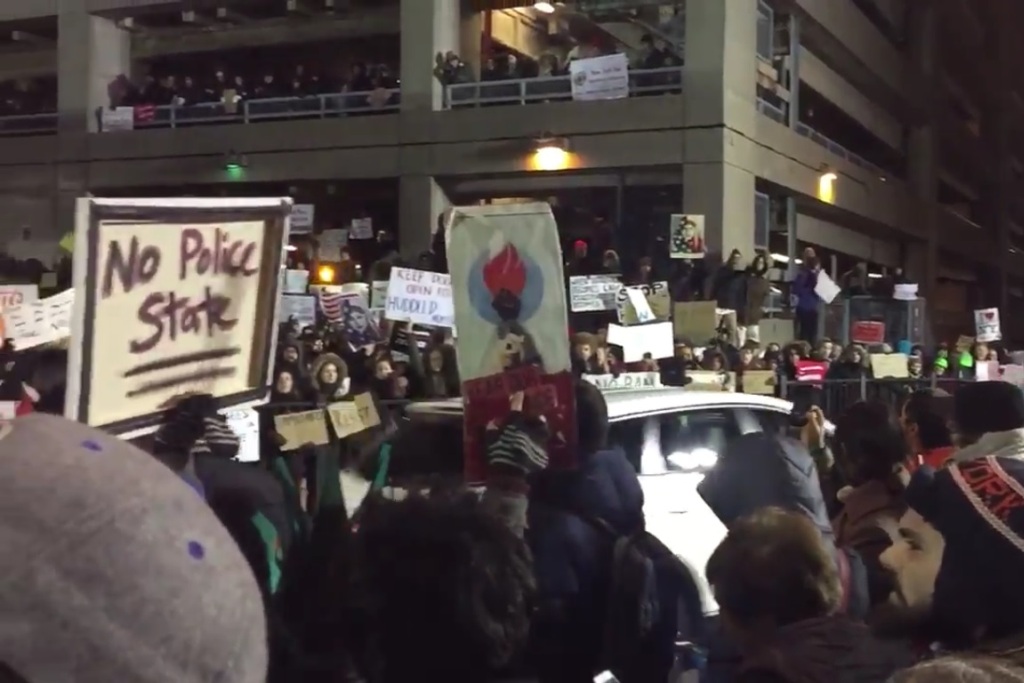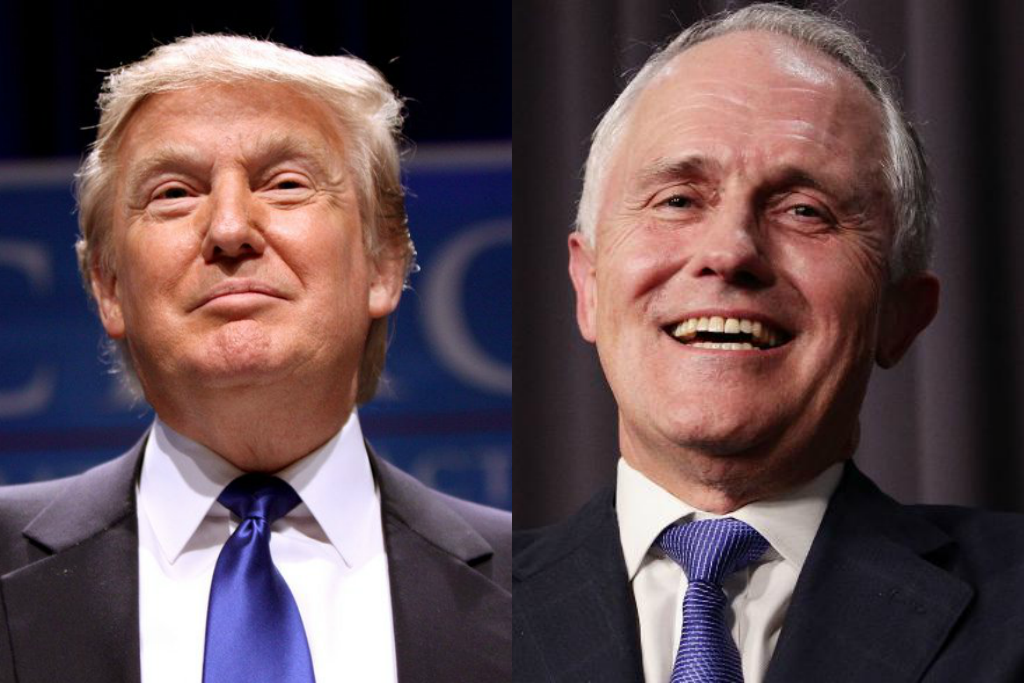Of Course Australia Won’t Condemn Trump’s Immigration Ban, It’s Straight Out Of Our Playbook
We have to understand the issue is much deeper than Trump, and much bigger than the US.

The Australian government’s refusal to condemn, or even criticise Donald Trump’s immigration ban in the past 24 hours has exposed us as an international embarrassment.
France, Germany, the UK, New Zealand and many more have distanced themselves from the policy that temporarily suspends immigration from seven Muslim-majority nations and halts refugee applications. Our foreign minister, Julie Bishop, has instead reiterated the government’s “support” for Trump’s “strong immigration and border protection policies”.
This morning, Malcolm Turnbull simply stated: “It’s not my job as Prime Minister of Australia to run a commentary on the domestic policies of other countries.” (Actually, it is, right? Especially when those policies directly impact Australian government decisions and the lives of Australian dual-nationals who might now be prohibited from travelling to the US.)
Former immigration minister Scott Morrison then went even further than Bishop and Turnbull, claiming the US immigration ban is an example of the country “catching up to Australia”.
Many Australians felt angry, confused and scared about Trump’s announcement. Some politicians and business figures have condemned it, and called on the government to do the same. But if there’s one country that shouldn’t be shocked by the immigration and refugee ban it’s Australia. As depressing and infuriating as it is to hear Morrison compare it to our own immigration policies, the fact is he’s right.
Some elements of Trump’s policy, and the way it’s been enacted, go further than anything implemented before in the US or Australia. But the ban on some immigrants and refugees hasn’t come out of the blue. It’s an evolution of discriminatory immigration policy rooted in Islamophobia and dangerous ‘war on terror’ rhetoric that’s been a feature of both the US and Australia since 2001. And when it comes to refugees, Trump’s policy is seeking to imitate Australia’s bipartisan cruelty.
What Does The Executive Order Actually Do?
There’s been an enormous amount of confusion about the exact detail of the new immigration policy. That’s because the executive order was written without consultation with the Department of Homeland Security, was interpreted in different ways by frontline border officials, then became subject to a federal court order restraining aspects of it before eventually being clarified by government officials. But let’s look at the facts that have settled so far.
During the election campaign Trump infamously called for a “total and complete shutdown of Muslims entering the United States”. Closer to the election, he narrowed his policy substantially, so it was a call suspend “immigration from terror-prone regions where vetting cannot safely occur”.
The executive order Trump enacted on the weekend is not a “total and complete shutdown of Muslims entering the United States”, but it is a suspension of immigration from so-called “terror-prone” regions — Iraq, Iran, Libya, Somalia, Sudan, Syria and Yemen — for 90 days. Why those countries? Despite suggestions the list was drawn up to protect Trump’s business interests, it actually came from his predecessor. Last year the Obama government enacted a law that made it harder for anyone who had visited these countries to come to the US.
In addition to this, all refugee applications from Syria have been indefinitely suspended, and refugee applications from the rest of the world have been frozen for 120 days.
It’s the total immigration ban from those seven countries that has attracted the most attention — arugably because the students, doctors and other professionals caught up in it aren’t usually the focus of US immigration crackdowns. Initially it seemed like permanent residents of the US would be caught up in the ban, and reports suggested some were blocked from travelling. But the Trump administration has now clarified the ban doesn’t apply to anyone who holds permanent residency.
So after a confusing 72 hours we finally have clarity. Non-US residents who hold citizenship in Iraq, Iran, Libya, Somalia, Sudan, Syria and Yemen will be banned from entering the US for 90 days, and all refugees will be banned from entering for 120 days. What happens next? We don’t know. The bans could be extended, new countries could be added to the list, or new vetting procedures for potential immigrants and refugees could be introduced.
Trump has now issued a statement on Facebook, saying “this is not about religion — this is about terror and keeping our country safe”. “There are over 40 different countries worldwide that are majority Muslim that are not affected by this order. We will again be issuing visas to all countries once we are sure we have reviewed and implemented the most secure policies over the next 90 days.”
Tens of thousands of Americans have taken to the streets in protest, accusing Trump of discriminating against Muslims and turning his back on refugees.
What Does This Have To Do With Australia?
Actually, a lot. Trump’s executive order referenced September 11 numerous times, despite the fact that none of those terrorists came from countries that are the target of the new immigration crackdown. But it’s not the first time September 11 has been used to justify cruel and discriminatory immigration policies.
The Howard government went out of its way to link “border protection” to national security in the aftermath of the September 11 attacks. In 2002, Peter Reith (a government minister at the time) said “security and border protection go hand in hand” and Peter Slipper (yes, that Peter Slipper) went further. “There is an undeniable linkage between illegals and terrorists,” he said.
There was no evidence at the time (or since) that terrorists were using the refugee program to infiltrate Australia’s borders. But Howard used the rhetoric to help build public support for his asylum seeker policies: indefinite mandatory detention and the Pacific Solution.
In 2002, Australia suspended asylum seeker applications from Afghanistan, citing national security. The processing freeze impacted 2,000 Afghanis and was only lifted after protests, including hunger strikes. Sound familiar? We were enacting Donald Trump’s policies back when he was still hosting beauty pageants.
The idea of freezing applications for asylum seekers isn’t unique to Australia of course. Even Obama suspended refugee applications from Iraq in 2015. But these moves in Australia arguably laid the groundwork of what was to come. Fast forward to 2017 and we have one of the cruellest immigration regimes in the world. We’ve been condemned by the UN and Amnesty International for our policies that include sending asylum seekers who arrive by boat to remote Pacific islands. The government is now trying to pass a law that would prohibit any refugee, from anywhere in the world, from ever being settled in Australia if they arrive by boat.
Trump’s refugee freeze is cruel and inhumane — particularly since it’s US military intervention that has played a role in helping generate the current refugee crisis — but his policy is still nowhere near as awful as Australia’s.
The story of one Iraqi refugee, who worked alongside US soldiers in Iraq, captured much of the world’s attention over the weekend when it was reported he had been detained at JFK airport in New York. That refugee was eventually granted entry in the US. In Australia we return asylum seekers to their home countries, even when they face death. A 2008 study found that 20 refugees Australia had returned to Afghanistan had been killed.
The difference between our refugee policy and Trump’s temporary suspension is stark. But what about the broader US immigration ban?
Since the dismantling of the White Australia policy in the 1970s, Australia hasn’t explicitly blocked nationals from certain countries from migrating. But that doesn’t mean our immigration system isn’t discriminatory. It’s much easier to travel to Australia if you’re a white person from Europe than if you’re from Syria or Pakistan, even if you have family here.
Don’t believe me? Look at the case of Hassan Asif, a terminally ill Pakistani man who was initially blocked from seeing his family before he passed away because the government wouldn’t grant them a visa. The Turnbull government eventually backflipped, but only after a public backlash.
How To Fight It
The point of this history lesson isn’t to whitewash Trump’s policy, or to argue that since Australia’s immigration system is fucked up we shouldn’t care about what happens in the US. The point is that, since 2001, politicians in the US and Australia (Democratic and Republican, Labor and Liberal) have created discriminatory and cruel immigration systems without much domestic backlash. The fact that they’ve been able to get away with it for so long is part of the reason why Trump can take it even further.
We have to understand and accept that the issue is much deeper than Trump, and much bigger than the US, if we really want to defeat these kinds of policies. Because even if Trump disappeared tomorrow, the ideology underpinning discriminatory immigration systems wouldn’t go with him. Politicians would keep finding ways to use national security to strengthen borders and build more walls. Australia’s heinous refugee policy predates Trump and looks likely to outlast him.
A movement focused on being anti-Trump is much less likely to succeed than one that is pro-migrant and pro-refugee. We’ve learnt that the hard way in Australia. It’s much harder to mobilise people against the policies of someone like Julia Gillard, even when she reinstated offshoring processing, than it is to build a broad campaign against someone as despised as Tony Abbott. Now, even though Abbott’s gone, our refugee policies have gotten worse and the Labor Party is still desperate to mimic the Coalition.
So we need to protest Trump, and we need to protest our government’s policies here. But we also need to articulate what a fairer immigration system looks like, make the case for why migration shouldn’t discriminate on ethnicity, religion or country of origin, convince the public, and force politicians to accept our position.
It’s not easy, and it’s definitely harder than just getting people fired up about Trump, but it’s the only thing that might turn us away from the current trajectory before it gets even worse.



